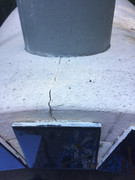|
|
Post by halfbaked on Sept 5, 2019 22:50:12 GMT
Hi All
I’d really like some advice on how to proceed with the following.
I’ve created flanges and screwed a 6 inch, single wall stainless steel flue to my brick arch. I stupidlyfilled the gaps and remaining space with fire mortar rather than a vermiculite cement mix. However, I did insulate over the area with a vermiculite cement mix (12-1 ratio). The insulation blanket comes up to the flue area, but not beyond it.
The plan now is to render the dome and arch area using a perlite (water repellent grade) render mix using the following ratio: perlite, sand, cement, hydrated lime: 5,1,1,1.
However, I’m doubting whether this mix will stand up the ferocious heat of the flue. Would I be best to ‘join’ the perlite render to the flue, using a vermiculite cement mix? I had thought about using a high heat sealant as a final ‘ring’ of protection and painting the vermiculite cement (and perlite render) with elastomeric paint.
Do you think this would work? Does anyone have any alternative suggestions, please?
A secondary concern is should I be sealing/ waterproofing my decorative arch against the elements?
My concern stems from anticipating that moisture may seep into the second arch firebrick vent area, which is obviously an area that I want to keep dry. There has been some slight cracking that extends from the flue to the decorative arch, due to lack of containment of heat***. Yes, I’ve cured the oven over 5 days’ worth of firing, reaching approx. 450 C.
***This is something that I will address properly next year, during the limited 2 week Scottish Summer. Unfortunately, it’s going to be a major job… but it will allow me to strategically address the smoke coming out of the mouth of the oven.
In the meantime, I’ve added another couple of inches of vermiculite cement. I’ve also read a little bit about freeze-thaw, which has me slightly worried.
Pics to follow!
Thanks in advance.
Tom
|
|
|
|
Post by oblertone on Sept 6, 2019 19:27:35 GMT
A demountable flue and a patio furniture cover from eBay serve to keep the 'Devon Sunshine' at bay; regular firings help too !
|
|
|
|
Post by downunderdave on Sept 7, 2019 8:41:01 GMT
A gap is often created between the render and the flue pipe which allows water entry. At worst the expanding stainless steel can crack the render that surrounds it creating further entry points. If the pipe is surrounded with some cardboard and then rendered up to it, on removal of the cardboard the gap, 5 mm or so can be filled with some high temperature silicon. This works as a reasonably successful solution for my oven design. The higher up the pipe the join is, the cooler and more successful will be the result. Also it supports the flue pipe better.
|
|
|
|
Post by halfbaked on Sept 7, 2019 9:38:06 GMT
A demountable flue and a patio furniture cover from eBay serve to keep the 'Devon Sunshine' at bay; regular firings help too ! Hi oblertone. I’m definitely going to have it covered during the winter months, but I’d prefer to have it exposed during the ‘good’ weather. It’s the approach to rendering up to the flue that I’m stuck on. Thanks |
|
|
|
Post by halfbaked on Sept 7, 2019 9:41:52 GMT
A gap is often created between the render and the flue pipe which allows water entry. At worst the expanding stainless steel can crack the render that surrounds it creating further entry points. If the pipe is surrounded with some cardboard and then rendered up to it, on removal of the cardboard the gap, 5 mm or so can be filled with some high temperature silicon. This works as a reasonably successful solution for my oven design. The higher up the pipe the join is, the cooler and more successful will be the result. Also it supports the flue pipe better. Hi Dave, thanks for that. |
|
|
|
Post by downunderdave on Sept 8, 2019 4:09:00 GMT
A gap is often created between the render and the flue pipe which allows water entry. At worst the expanding stainless steel can crack the render that surrounds it creating further entry points. If the pipe is surrounded with some cardboard and then rendered up to it, on removal of the cardboard the gap, 5 mm or so can be filled with some high temperature silicon. This works as a reasonably successful solution for my oven design. The higher up the pipe the join is, the cooler and more successful will be the result. Also it supports the flue pipe better. Here is a typical problem that I've seen in more designs than I can count  |
|
|
|
Post by halfbaked on Sept 16, 2019 7:28:12 GMT
A gap is often created between the render and the flue pipe which allows water entry. At worst the expanding stainless steel can crack the render that surrounds it creating further entry points. If the pipe is surrounded with some cardboard and then rendered up to it, on removal of the cardboard the gap, 5 mm or so can be filled with some high temperature silicon. This works as a reasonably successful solution for my oven design. The higher up the pipe the join is, the cooler and more successful will be the result. Also it supports the flue pipe better. Here is a typical problem that I've seen in more designs than I can count  Amen to that. That’s exactly what’s happened to me, after applying more insulation under the render. |
|